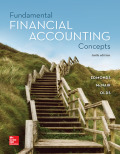
a.
Determine the number of times interest was earned for Company F for Year 3 and Year 2.
a.
Explanation of Solution
Number of times interest is earned: Number of times interest is earned quantifies the number of times the earnings before interest and taxes can pay the interest expense. First, determine the sum of income before income tax and interest expense. Then, divide the sum by interest expense.
Determine the number of times interest earned of Company F for Year 2.
Determine the number of times interest earned of Company F for Year 3.
Hence, the number of times interest earned of Company F for Year 2 and Year 3 is 9.38 times and 9 times respectively.
b.
Compute the earnings per share based on the average number of shares outstanding for Company F for Year 3 and Year 2.
b.
Explanation of Solution
Earnings per Share: Earnings per share help to measure the profitability of a company. Earnings per share are the amount of profit that is allocated to each share of outstanding stock.
Determine the earnings per share of Company F for Year 2.
Determine the earnings per share of Company F for Year 3.
Hence, the earnings per share of Company F for Year 2 and Year 3 are $7.20 per share and $8 per share respectively.
c.
Determine the price earnings ratio for Company F for Year 3 and Year 2.
c.
Explanation of Solution
Price/Earnings Ratio: The price/earnings ratio shows the market value of the amount invested to earn $1 by a company. It is major tool to be used by investors before the decisions related to investments in a company.
Determine the price/earnings ratio of Company F for Year 2.
Determine the price/earnings ratio of Company F for Year 3.
Hence, the price earnings ratio of Company F for Year 2 and Year 3 is 3.33 times and 3.75 times respectively.
d.
Determine the return on equity.
d.
Explanation of Solution
Return on average equity: It is one of the profitability ratios. Return on average equity ratio is used to determine the relationship between the net income available for the common stockholders’ and the average total stockholders’ equtiy. Return on equity is calculated as follows:
Determine the return on average equity of Company F for Year 2.
Determine the average total
Determine the return on average equity of Company F for Year 3.
Determine the average total stockholders’ equity.
Hence, the return on average equity of Company F for Year 2 and Year 3 is 40.00% and 38.78% respectively.
e.
Determine the net margin.
e.
Explanation of Solution
Net profit margin: It is one of the profitability ratios. Profit margin ratio is used to measure the percentage of net income that is being generated per dollar of revenue or sales. It is calculated by using the formula:
Determine the net margin of Company F for Year 2.
Determine the net margin of Company F for Year 2.
Hence, the net margin of Company F for Year 2 and Year 3 is 13.50% and 12.80% respectively.
Want to see more full solutions like this?
Chapter 13 Solutions
Fundamental Financial Accounting Concepts
- Nonearrow_forwardIndira Products has provided the following data for the month of August: a. The balance in the Finished Goods inventory account at the beginning of the month was $65,000 and at the end of the month was $29,500. b. The cost of goods manufactured for the month was $210,000. c. The actual manufacturing overhead cost incurred was $71,800 and the manufacturing overhead cost applied to Work in Process was $75,200. d. The company closes out any underapplied or overapplied manufacturing overhead to the cost of goods sold. What is the adjusted cost of goods sold that would appear on the income statement for August?arrow_forwardLand should be capitalized at what amountarrow_forward
- Delta Tools estimated its manufacturing overhead for the year to be $875,500. At the end of the year, actual direct labor hours were 49,600 hours, and the actual manufacturing overhead was $948,000. Manufacturing overhead for the year was overapplied by $81,400. If the predetermined overhead rate is based on direct labor hours, then the estimated direct labor hours at the beginning of the year used in the predetermined overhead rate must have been _.arrow_forwardWhat is the depreciation expense for 2022arrow_forwardCan you solve this financial accounting question with the appropriate financial analysis techniques?arrow_forward
- Julius provided consulting services amounting to P420, 000. His total expenses were 25%. His net income is: A. P105,000 B. P300,000 C. P315,000 D. P120,000arrow_forwardWhat is the cost of goods soldarrow_forwardSnapGallery Inc. sells one digital poster frame. The sales price per unit is $12. The variable cost per unit is $7. Fixed costs per annum are $13,500 and having a sales volume of 5,000 digital poster frames would result in: 1. a profit of $11,500 2. a loss of $2,500 3. breaking even 4. a profit of $8,000arrow_forward

 AccountingAccountingISBN:9781337272094Author:WARREN, Carl S., Reeve, James M., Duchac, Jonathan E.Publisher:Cengage Learning,
AccountingAccountingISBN:9781337272094Author:WARREN, Carl S., Reeve, James M., Duchac, Jonathan E.Publisher:Cengage Learning, Accounting Information SystemsAccountingISBN:9781337619202Author:Hall, James A.Publisher:Cengage Learning,
Accounting Information SystemsAccountingISBN:9781337619202Author:Hall, James A.Publisher:Cengage Learning, Horngren's Cost Accounting: A Managerial Emphasis...AccountingISBN:9780134475585Author:Srikant M. Datar, Madhav V. RajanPublisher:PEARSON
Horngren's Cost Accounting: A Managerial Emphasis...AccountingISBN:9780134475585Author:Srikant M. Datar, Madhav V. RajanPublisher:PEARSON Intermediate AccountingAccountingISBN:9781259722660Author:J. David Spiceland, Mark W. Nelson, Wayne M ThomasPublisher:McGraw-Hill Education
Intermediate AccountingAccountingISBN:9781259722660Author:J. David Spiceland, Mark W. Nelson, Wayne M ThomasPublisher:McGraw-Hill Education Financial and Managerial AccountingAccountingISBN:9781259726705Author:John J Wild, Ken W. Shaw, Barbara Chiappetta Fundamental Accounting PrinciplesPublisher:McGraw-Hill Education
Financial and Managerial AccountingAccountingISBN:9781259726705Author:John J Wild, Ken W. Shaw, Barbara Chiappetta Fundamental Accounting PrinciplesPublisher:McGraw-Hill Education





